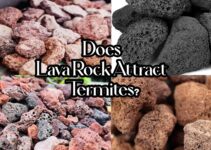All About Termites’ Life Cycle, Colonies, and Habitats
Termites is are a group of social insects that look a lot like ants but are actually more closely related to cockroaches. They are swarm insects and form termite colonies. They’re a major part of most ecosystems since they break down dead plant materials, including leaf litter, wood, soil, and many other things that wouldn’t deteriorate on their own. Without them, there would be a lot more dead wood around.
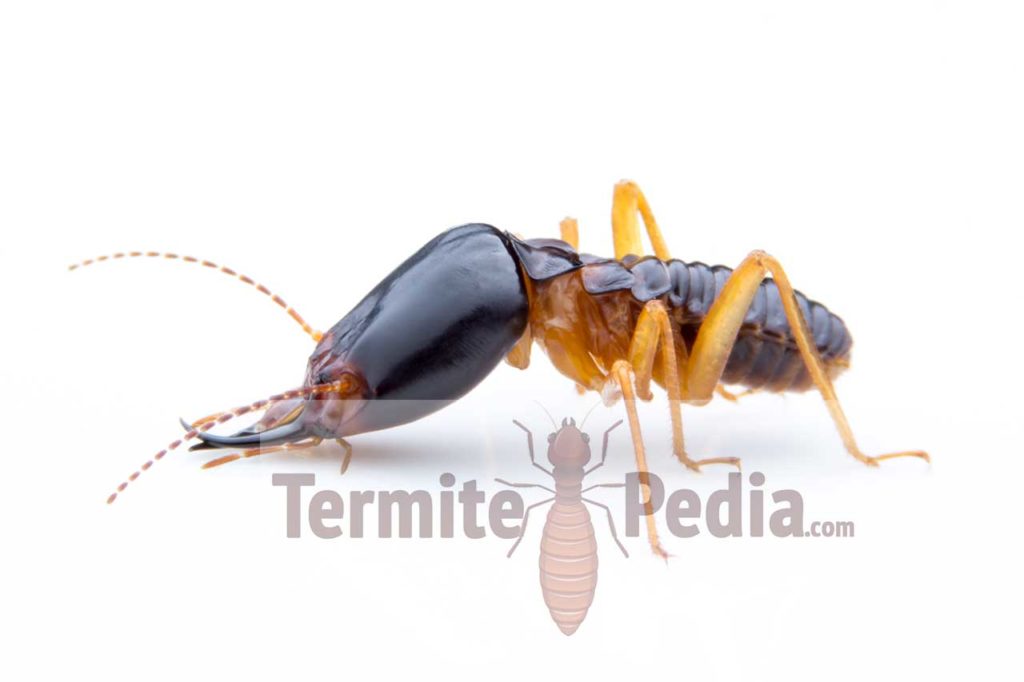
When termites end up around humans, the traits that are normally good and important in the rainforest turn out to be mad. Around ten percent of the near four thousand different kinds of termites are major pests, causing serious damage to forests, crops and buildings.
Termites are social insects that live in termite colonies. Depending on the species, a single colony could have only a few hundred individuals in it, or up to several million. Typical termite colonies include several different kinds of termites, including nymphs (young termites), soldiers, workers, kings and queens.
Termite Queens
Unlike many other hive insects, termites have multiple queens in many colonies. The primary queen is the one that founded the termite colony, but there may be secondary queens as well.
The queen is much larger than other termites and has an elongated abdomen. She can lay an enormous number of eggs (over 1000 eggs) each day and is responsible for the population growth of the termite colonies. The Queens are the only egg layers in the colony and when they are all killed, the colony may not continue until a new queen may simply create a new one from a soldier, otherwise, they’ll die off.
Termite queens are what it says on the name, they are the queen. Termites are colony insects and they live in large specialized nests with specialized functions. As bees have a queen bee that rules the roost so does termites have a Queen too! She has an extremely important function of controlling and being responsible for reproduction.
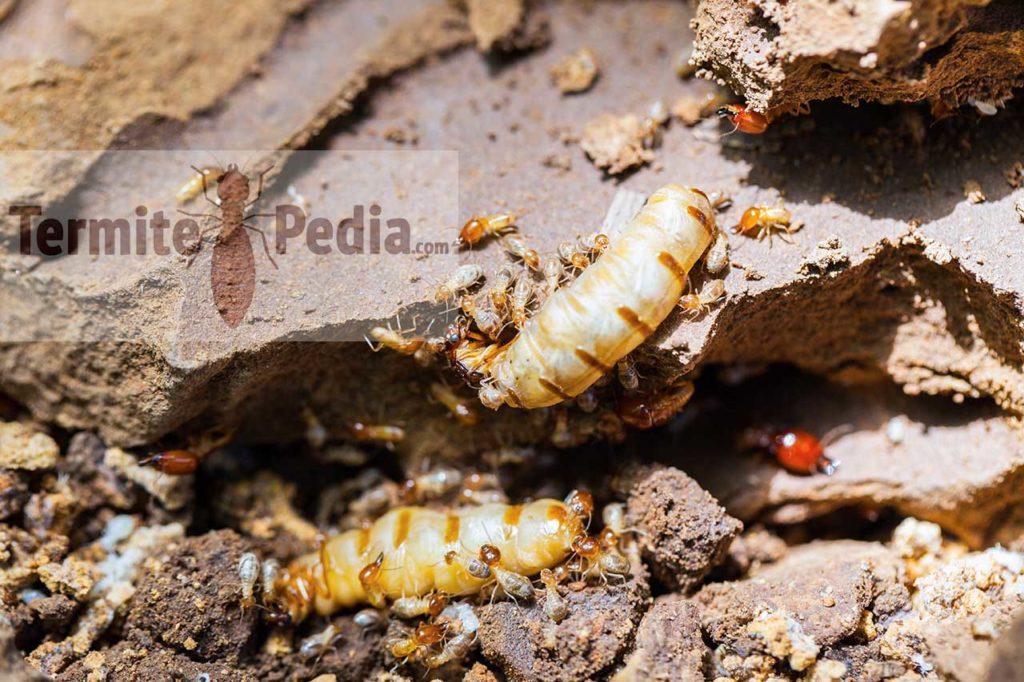
Termites do have multiple kings and queens which is another reason they are so difficult to eradicate once they have taken hold. When a new nest is formed any female termite that has mated and produced eggs is called a queen. The males that have mated with her then stay around her and they are the kings and there may be many more than one king and queen in the nest. Equally when one dies another of the workers takes over her function.
However, even termites have their pecking order and one queen will be the nest’s primary queen. A fully mature termite queen can lay over two thousand eggs daily and not surprisingly this makes her rather fat and she has to be attended to by worker termites.
Worker termites provide the food for all in the nests and the queens are no different. Once a worker becomes a queen then they develop extra ovaries and a distended abdomen to cope with the sheer volume of eggs in her abdomen. Pheromones emanating from the queen are spread via shared feeding to all the termites and it prevents other kings and queens from developing. So a queen can change the balance of power in the nest.
Destroying a termites’ nest is a harder task than identifying the queen and exterminating her because other queens are present and will replace the primary queen’s functions when she dies. Even if the nest is no longer viable a new colony can be begun by a queen and a few workers, in fact, a colony does not need a queen, just the workers with one taking on the work of the termite queen.
This is another reason why it is almost impossible to eradicate a termite colony once it has become established; there are too many candidates to take the role of the queen.
Although killing a queen can be difficult it is possible to isolate the queens and cut off their food supply. All food comes into the nest via the termite workers, and if the termite workers can be diverted then the queens will starve. This technique for termite control involves a barrier method, which in effect can be chemical or physical.
Boric acid acting as an insecticide can divert the workers. Others involve rather more toxic chemicals and the workers will find another route rather than cross it. This does not necessarily kill the colony but what it does do is prevent the termite colonies from expanding as the environment is not perfect for expansion.
It is hard to poison an entire colony of termites unless you use termite tenting and gas them up. However, termite baits, termite traps, and termite insecticides are an important deterrent. Learning where they are likely to be and deterring them is the most effective way to deal with these pests.
Termite Life Cycle:
Termites live for different periods of time. Queens have been said to live as much as fifty years, but the average worker lives only a year or two.
Termites hatch from eggs laid by the queen and spend their early lives as nymphs – fed by workers. They then grow into specific types of termites, as determined by pheromones in the colony.
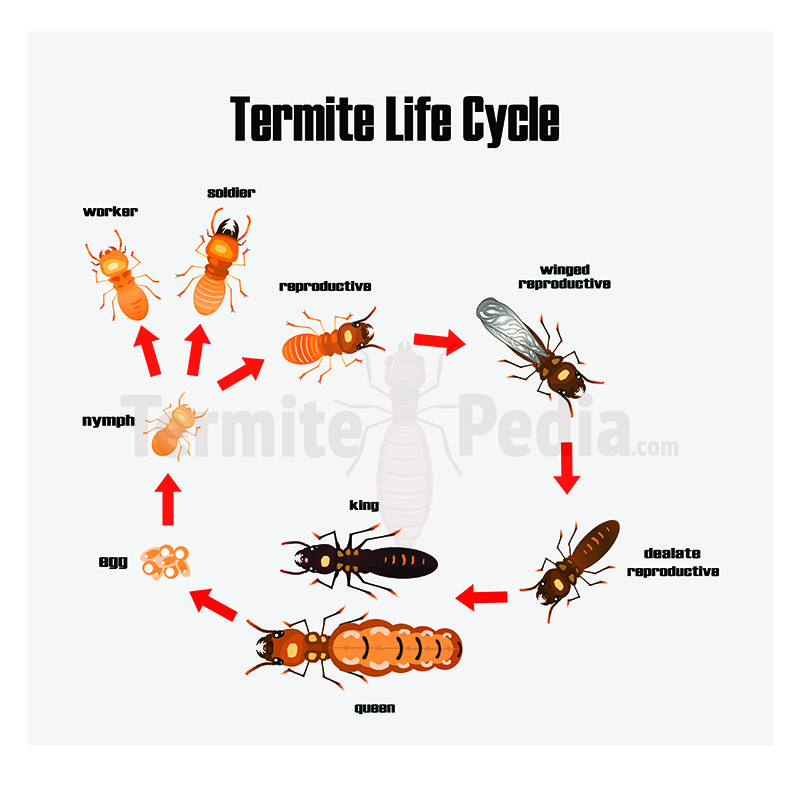
In certain temperate and warm climates, termites and termite damage are a serious problem. In general, the damage from termites costs over five billion dollars annually. It makes sense that if your house is in an area at risk of an infestation, then you should be aware of the dangers and the practical steps that you can take to make your property as termite-proof as possible.
Once you understand that once an infestation has taken hold, they are extremely difficult to control and eradicate than it makes more sense to pay attention to the preventative measures that you can take.
To understand termites it is necessary to understand their life cycle, how it reproduces and when.
Its life cycle is standard and how the nest develops does to some extent, depend on the prevailing conditions. If the conditions are favorable then the nest will grow exponentially, and this will become apparent when you understand how a termite’s nest grows.
There are three types of termites in a nest, and they have specialized bodies because their functions are different. There is a single Queen, and then there are the termites that reproduce, the soldiers and the largest group, the workers. The workers are the majority because they carry out the most diverse tasks.
The workers do not guard the nest against predators or reproduce, but they have to do all the other basic tasks. They provide the food for all and take care of the underdeveloped nymphs. Workers’ are hermaphrodite which means that they have the characteristics of both males and females, but they are sterile because the Queen and the reproducers create new termites to be hatched.
The workers have to be in a warm humid and dark environment as the light damages their nearly translucent bodies. When they obtain food, they seek out wood, cellulose or plant materials as well as crops. As well as getting food and nurturing the underdeveloped termites they have also to maintain the nest and expand it to make it safe for the growing colony.
Dry wood termites’ nests take several years to develop to their full capacity. However, the subterranean, are more aggressive and they can establish a new nest very quickly. Their life span is between one and two years, but they are expendable because of their large numbers.
The soldier termites are also soft bodies, sterile, wingless and blind, yes the have no eyes.
Their strength is their ability to spit a protective sticky white gooey substance to repel any attack from predators; they have no defense against chemicals. As they are blind, they are helpless and totally reliant on the workers to care for them. Numerically they are second on the pecking order there are less of them than workers but more than reproductives.
The soldiers vary more than the other types between species so they can be important in establishing what type of termites you have because different species of termites are controlled in different ways.
The top dog in the termite world is the king and queens, they are there to expand the numbers in their nest. They have no other function but to hatch other termites. If they die then the workers who have the characteristics of both sexes can take over their job. However, under normal circumstances, they produce hormones or pheromones which prevent the workers from becoming queens which would upset the balance of the colony.
Once the Queen has established herself in a new nest then she sits back and grows enormous with new eggs to be hatched.
The egg hatches into an immature termite which is actually correctly referred to as a nymph. This will grow to become a worker, soldier or reproductive. However, no role is necessarily permanent!
One of their strengths, why termites survive and get stronger, is the fact that their gender and function can be reassigned. That means if the colony is short of reproductives the workers can take over their job.
Understanding the strength of the termites and why they reproduce the way they do will make it easier for you to understand that prevention is the best step to control termites.
Identification of Termite Eggs
The eggs that termites lay are unlikely to be visible to humans unless you happen to open up a colony. The eggs are tiny and usually white or yellowish. They’re nearly transparent, as well. They may look like much smaller grains of rice.
It is natural to feel worried when you wonder if the insects “eggs” you see are in fact mere insect eggs, especially if you live in a termite prone area. However you rarely see termite eggs, they are laid in tunnels and they are not tough enough to survive outside their tunnels.
Most adult termites have soft translucent exoskeletons and they are very sensitive to light so they live in dark areas with moisture. The eggs that you may observe outside a colony are likely to be dead and those that are not will probably not survive the ordeal. The termites’ eggs that you have to be concerned about are those that can’t be seen.
The queen is capable of laying two thousand eggs in a day and these hatches into two thousand termites. The young subterranean termites hatch into three castes with three distinctive tasks. They are the soldiers who repel invaders, the reproductives, and the workers who have to feed the colony.
It is the workers that cause all the damage because they feed off wood to take it back to the nest. The nymphs’, soldiers and reproductives cannot feed on their own so they rely on a large number of workers. The workers also protect the unhatched eggs.
The termites in general cannot survive outside of their colony which means that part of a colony can be moved and it will not spread. If you use compost made from infected wood it does not spread the termites. Moving wood that is infected is often not a problem. That is because the termites only use the wood as a source of food, they actually nest in damp soil.
In certain environments, termite colonies can establish another colony above the ground but they have to have moisture. If you remove the moisture then the termites will have to vacate the nest. Any environment that is wet enough to support termites will be visibly wet from the outside.
Once a colony of termites has become established, they are difficult to eradicate and whilst poisoning is used it has varying degrees of effectiveness.
To eradicate and wipe out a colony you have to kill every single termite in that colony. If a queen remains she can hatch another two thousand eggs a day and all that is necessary is a few hundred workers who will provide food.
If the Queen dies for any reason then one of the workers will become the queen, and all that is necessary is reproductive male and the cycle of termites eggs begins again. So it is far simple to take effective preventative measures to discourage termites from being able to create a nest.
Although termites’ are invasive and destructive, the reproductive process can be flawed. Every situation is unique and it is important that you are aware of the circumstances of your infestation.
Serious infestations will always require professional help, but sometimes a termite problem merely needs monitoring.
Termite eggs can be fragile they are easily damaged by light, sunlight, and heat; they prefer dark warm humid conditions.
Termite Larva:
Newly hatched termites of most species look like tiny, soft white versions of the adults. They’re unlikely to be seen by humans unless a nest is breached.
There are a number of different signs that termites may be in your home. For instance, termites may create mud tubes or mud tunnel for travel and for keeping their nests secure.
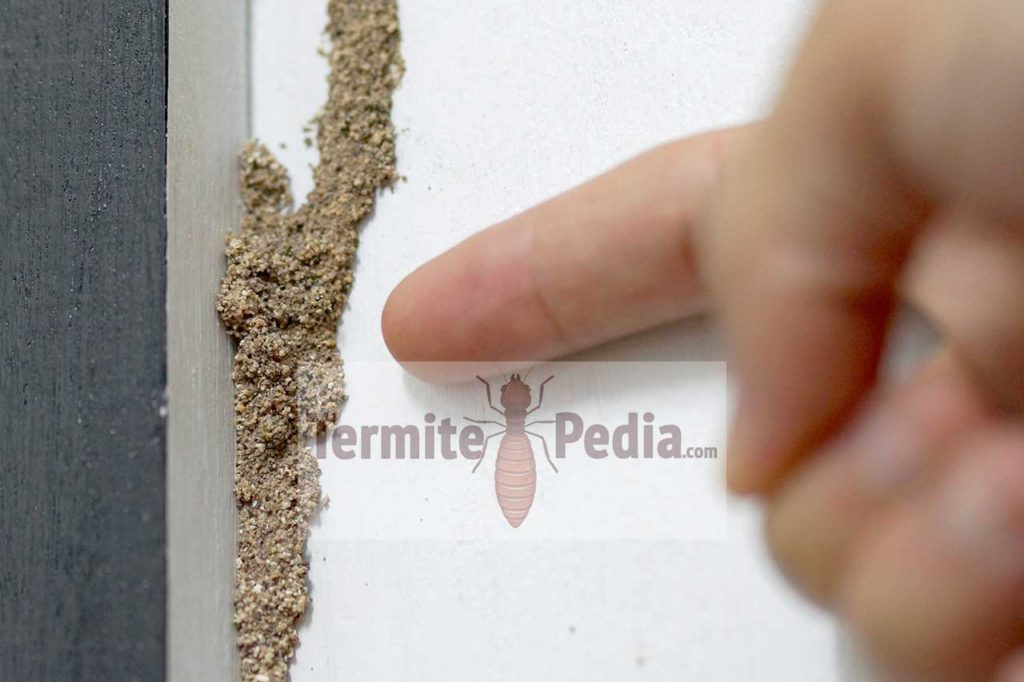
If you see what looks like mud on your foundation or on wooden surfaces, you may have termites. The shed wings of reproductives like the king and queen are another warning sign, as is a powder that looks like sawdust, bubbling paint, small holes in wood surfaces, hollow-sounding areas in wooden parts of the house and, of course, actual termites. You may also see termite droppings (also called termite frass) in small piles around your home if you’re dealing with drywood termites.
Identifying Termite Tubes
If you’re concerned about whether or not your home has termites, you may have heard that termite tubes are one sign these insects are present. Termites aren’t able to live in dry conditions, so they need shelter to move.
They build tubes up foundations and across other surfaces they can’t dig through, looking for wood and other cellulose to feed off of. These tubes are built out of soil and termite feces, and allow these bugs to bring their preferred damp environment along with them. Tubes of this kind can let termites into your home without you noticing.
It’s easy not to see tubes when it’s being built. They’re usually constructed in dark, moist corners where they’re hard to see. If you have shrubs or bushes in front of the house, they might also obscure the tubes as they’re being constructed. Look for long, thin tubes of dirt stretching along with your foundations if you’re not sure what you might find. They can be built extremely quickly.
In one case, tubes were scraped off, and within forty-eight hours, two feet of mud tube had been rebuilt. That’s why you have to be attentive when it comes to removing these tubes – termites are capable of putting them back extremely quickly. You’ll need to look for and remove them on a regular basis if you want to keep these bugs from infesting your home. Prevention is much better than trying to fight them once they’re established.
A wet tube is actively being constructed and has termites in it when you’re looking at it. If you look at it long enough, you’ll even see termites poke their heads out from time to time!
The tube is built one tiny piece of mud at a time and can be incredibly long. These bugs will keep building until they find a food source! If you break open a tube, you may see termites scuttling away inside it. These will generally be worker caste.
Termites don’t just build their tubes on the outside of your home, however. They can also construct tubes out of the mud and other materials inside your home, if they’re on any material that’s not conducive to making tunnels.
Once they reach a piece of wood, they start tunneling into it, creating their preferred environment inside it. That’s why they’re so hard to see. If you see a channel in the outside of a piece of wood, it’s because termites have been in it for some time, and have exhausted their supply inside.
Holes made by termites in the outside of a piece of wood indicate a lot of damage has already been done inside.
Anyone who lives in an area where termites are common should take a walk around and make sure that there are no termite tubes leading up onto their foundation.
Tubes of this kind can be built extremely quickly, and aren’t always noticeable. If you see a tube, remove it. Keep bushes, pieces of wood, and other objects that termites can eat off the ground near your home, too. That’ll keep termites from getting a foothold and establishing the colony that could destroy your home.
What Are Termite Droppings
These are one sign that you may have termites, and usually indicate an infestation of drywood species. They’re granules, a little bigger than salt or pepper, and are dry and brownish. They appear at the base of a piece of wood that termites are living in, and are kicked out of a hole by the insects. Droppings of this sort will usually appear in small piles around your home or another infested area.
Termites and Wood
Termites love to eat wood, but they don’t like to eat all wood. Some species are more attractive to these insects, and some repel them. There are also some treatments you can use to make wood less desirable to termites. For instance, ordinary wood can be painted with borax or boric acid, or injected with orange oil (D-limonene) to make it unpalatable to and kill these creatures.
Woods that termites love include most hardwoods and many conifers. However, they’re less eager to eat redwood, western cedar, teak, tallowwood, relatives of the neem tree, and several Japanese species. Building solely with these woods may be difficult, but they’re an excellent choice when available.
Since termites are swarm insects then they form efficient functioning termite colonies so if you see one there is definitely more.
To see how powerful and dangerously hungry termites can be, check out Dr. Mike Bentley’s “will they eat it” at pestworld.org
